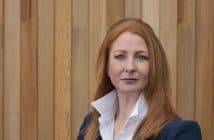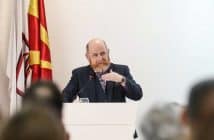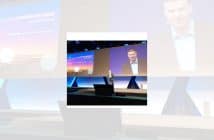Irish Building Magazine meets the dynamic team behind Event, Europe’s leading exhibition design consultancy group.
In conversation with Steve Simons and Celestine Phelan, co-founders of Event, an exhibition design company internationally renowned as pace setters in museum design.
“It’s about storytelling. Even if we’re working on something in a distant culture, we find a way for the audience to connect with the period, the people, and how they experienced their lives. And what you find is, things don’t change that much in essence.”
Founded in 1986 the idea of Event was born from a desire to push boundaries in design and storytelling. “We both felt that there was a wider world out there, that wasn’t being explored,” Phelan explains. A Dubliner, Cel began her career in broadcasting at R.T.E., before moving with her husband Bill to the UK and immersing herself into the design world, scripting the narrative for the British Pavillion at Expo ‘86. It was there that she met Steve, who was the lead designer on the project, and the idea for Event took shape. Their common love of storytelling and focus on communication, coupled with audience response was the foundation on which Event’s success is built.
“We’ve always felt that if you’re selling something to a client, you need to see it right through and that impacts every single element of the project.” Simons believes that a clear vision has been the key to their success, and Phelan agrees. “We’ve been on a learning curve ever since we began,” she explains, “and we have gathered intellectual capital along the way. Over time, we have developed expertise in the planning as well as the design of museums. At the beginning, we were just designing exhibitions, now as a company we understand how museums work, what underpins them, so more and more we are doing the master-planning for new-build museums around the world.”
Creatively, it is Steve Simon’s vision that informs Event’s work. His ability to get under the skin of a project and translate its message into one that can be digested and integrated by international audiences is at the heart of the studio’s success. From the start, however, Cel was highly attuned to the business side of the company. “Event has always been a business. It was set up as a business, and it remains a business,” she asserts. “When I went home to my husband to tell him that Steve and I were thinking of doing our own thing, he said ‘take a piece of paper and write out what you are going to sell, and to whom’. I did that, and identified what we could offer, which was of course, Steve, and his imagination and creativity and energy and vision.” Event’s success has lain in this two-strand approach to the business. As well as a background in storytelling, it is Phelan’s business acumen that helped to direct Simon’s creative spirit into projects that would be fruitful, both creatively and financially and it has enabled Event to offer permanent employment to a wide range of talented people and thus retain its precious intellectual capital in house.
From its inception, Event aimed to become front runners in museum design, and to date, has delivered over one hundred and seventy major projects around the globe, winning numerous awards and working with some of the world’s leading architects, including Daniel Libeskind, Norman Foster and Zaha Hadid. Their projects whether in Moscow, Warsaw, Abu Dhabi or Glasgow, are rooted in a cultural sensitivity to both the subject matter and its audiences. This, coupled with a determination to push the boundaries of audience perception through a variety of visual and sensory mediums has resulted in cutting edge designs that provide a multi-faceted platform for their projects.
Event Ireland was established in 1994, fulfilling Cel’s longstanding dream to have an office in her home city. Since then, it has developed visitor experiences all over the country, including Titanic Belfast, the GAA Museum, the House of Waterford Crystal and the Sadler’s Wells Legacy Gallery at Coolmore. “We’ve always worked in Ireland” says Cel, “This is where my roots are. You need to be inside the skin of a culture in order to explain it and express it to other people.”
This ability to get under a project’s skin is beautifully illustrated in Event’s work at The Guinness Storehouse (2007). “The interesting thing about that project is that it was started by another UK company,” explains Steve. “The architecture is just fantastic, their work really laid the groundwork for us. What we found when we were asked to be involved with it, and analyse how it could be better, is that people just weren’t getting it. The way they were communicating with people wasn’t allowing them to do what they really wanted to do, which was understand how Guinness was made, and enjoy it. Our job was to humanise the process, and give them a lovely place to do it in.” Event delivered a meaningful and highly engaging rejuvenation of the Guinness Storehouse experience, resulting in an interactive visitor attraction that remains one of the most popular cultural attractions in Ireland today.
The National 1798 Centre in Enniscorthy was an opportunity for Event to translate a local story to a wider audience. According to Steve, the solution was simple. “Our feeling there was that it was something that we wanted to involve the people of that town in. We reenacted the Battle of Vinegar Hill using local people rather than actors, and the reaction was just fantastic. It’s telling the story in the way that ordinary people can associate with. That’s what we do. We search for a connection so that when they look at it, people who see it are immediately involved, and it has a reality for them.” Simons believes that visitors are easily turned off by exhibitions that are vague or distant from their audiences, and in this way, tries to involve local peoples in the projects that he heads up, in order to provide a resonant backdrop from which to pose a project.
This resonance is wholly evident in Event’s work at the GAA Museum. “The old museum had loads of medals and kit and stuff, but it didn’t actually make a link to ordinary people. It lacked dynamism,” asserts Simons. “We looked at the GAA and what it means to Ireland; it is one absolutely extraordinary and unique organisation. It is embedded so deeply in the psyche of all Irish people in one way or another, and it isn’t just a sporting organisation, it’s a life organisation. It is something that is really at the root of all communities and that’s what we wanted to try to illuminate. The second part was to make it a celebration of great sporting achievement and let people see a lot of people doing sport very well and getting involved in the GAA.” The new museum captures this dynamism and energy of the GAA, encouraging visitors to try their hand at the core skills required in Gaelic Football and Hurling through interactive exhibits, and at the heart of the museum, all the GAA trophies are displayed together for the first time. The museum captures the spirit of the GAA, involving all members and encouraging the fans of the future to take their part in the organisation.
The opening of the Chester Beatty Library in the clock tower at Dublin Castle (2000) remains close to Cel’s heart. “I knew the collections from when I worked in RTE. I really wanted the job because there were these wonderful collections in Shrewsbury Road so in need of TLC and when the opportunity came for a redesign, I totally identified with it,” she explains. “What you obviously have there is a collection of artefacts which have not started out their lives in Ireland,” she goes on. “What we were trying to do was to build an interface, a bridge, between where Irish people are coming from when they come to see these objects, and what objects themselves have to tell them about other cultures. Of course, Ireland now is home to many cultures, but even twenty ago it really was not. So, the Chester Beatty uses its collections and its terrific programme of events to reach out to the many communities now flourishing in Ireland, whom these artefacts represent.” The Chester Beatty Library went on to win the coveted European Museum of the Year in 2002, and remains one of the city’s most visited attractions.
In 2009, Event took on the mammoth task of creating Titanic Belfast. The experiential visitor attraction that has rejuvenated and revived Belfast tourism, thanks to the storytelling genius of Simons and his team. “We decided very early in that project that we weren’t going to dwell on the tragedy, we were going to focus on the success of Belfast as a manufacturing city,” he asserts. “Belfast was one of the most important ship building centres in the world at that time, so once you establish that it’s no surprise to people that it managed to create a ship like the Titanic. We felt that the real story was the production of the ship, and the powerful effect it had.” Once the story was in place, the team set about looking into how the ship was recovered. Titanic Belfast has been so successful that it tripled its forecast visitor figures in year one and celebrated its millionth visitor in Summer 2013. Now the team are setting about improving and rejuvenating parts of the exhibit: “Now it can afford to look at itself and think, ‘where can we improve?’ ‘Where can we make it better?’ Any good attraction does that, because that’s the way it survives.”
Today, Event stands out as a trendsetter for museum design. It has moved beyond transforming existing spaces into exhibits and is now brought in to master-plan new build museums before an architect has put pen to paper. Working with architect Zaha Hadid Architects, Event created the master plan and designed the displays at Riverside Museum in Glasgow, this year’s European Museum of the Year, lauded for actively engaging its audiences and renew the relevance of its collections and the stories they hold. This is just the latest world class example of how Event is helping to shape the future of museums and by ensuring that the connection between exhibit and visitor is potent and meaningful.
From lofty heights of museum master planning, to the intricate work involved in facilitating a collection of prehistoric fossils, Event’s approach remains the same. “Whatever the project, our task is to enable our clients to realise their goals– that’s the job,” Cel asserts. “Every project has strengths to be built from and challenges to be met. Once you get under the skin of a particular personality, place or story, you become absorbed, then immersed. Steve and I have been on an absolutely terrific journey over the last twenty seven years and the future looks brighter than ever.” www.eventcomm.com





